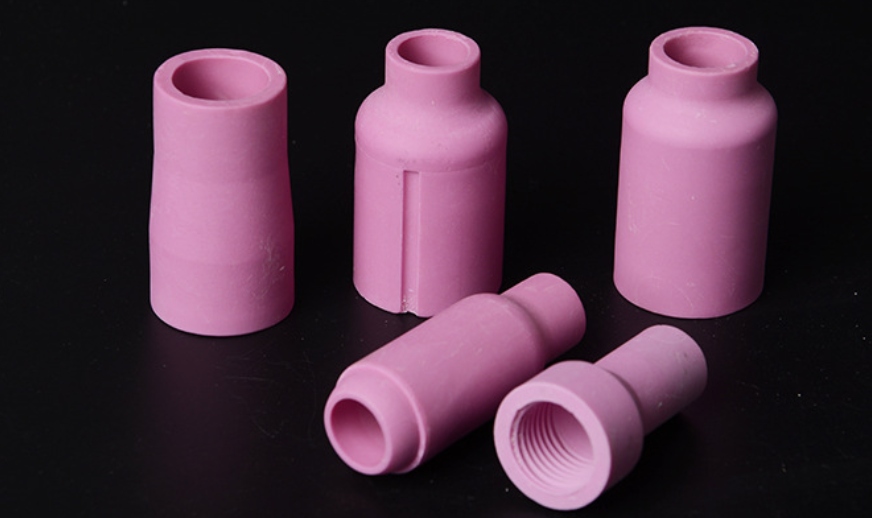Alumina Ceramic Nozzle
Alumina nozzle boasts high corrosion resistance and thermal stability, making them suitable for use in harsh working environments. Furthermore, these ceramic nozzles boast great strength and precision when it comes to waterjet cutting applications that demand abrasion resistance, corrosion resistance and precision.
As soon as suspension development and parameter optimization were complete, printing and thermal processing of new 2.5 N and 10 N alumina aerospike trust nozzles could proceed successfully. Visual inspection showed no cracks or other major flaws within these components; no defects of any kind existed either.
High purity
These alumina ceramic nozzles are made from one of the highest quality materials on the market, providing superior resistance against abrasion. Not only are they precision pieces but they’re also easy to keep clean since they do not accumulate dust easily.
ceramic nozzle has the capacity to withstand high temperatures and corrosion, making them the ideal material for furnace applications as well as chemical processing processes. A variety of shapes and sizes is available for various industrial uses.
These ceramic sandblasting nozzles are manufactured in the US using alumina oxide ceramic for maximum wear resistance and come rated to handle blast pressure of 1200 PSI for longer-term service than other ceramic nozzles.
Alumina is a non-conductive material, capable of being metallized to produce an array of products such as ceramic-to-metal bonded assemblies for high vacuum systems, plasma resistance components in electron microscopes, microwave windows for medical and laser equipment as well as fluid handling parts. Furthermore, Alumina fabrication tolerance can reach close tolerance.
High abrasion resistance
Alumina ceramic offers superior abrasion resistance, making them an excellent material choice for use in applications where corrosive or abrasive materials come into contact with them. Furthermore, their thermal stability makes alumina ceramic nozzles suitable for high temperature environments – qualities which make alumina ceramic nozzles an excellent option in many demanding industrial processes such as surface treatment and waterjet cutting.
Ceramic nozzles boast excellent abrasion and corrosion resistant properties as well as high durability, increased tolerance for dimensional variations, and lightweight construction compared to their metal counterparts – these features make them the ideal choice for applications involving pressurized streams of abrasive media such as blasting, sandblasting or any others that require precise control of a pressurized stream of such media. Furthermore, their superior wear resistance means longer periods of use and reduced maintenance and operational costs due to ceramics’ superior wear resistance compared to metal counterparts resulting in reduced maintenance costs over metal counterparts compared with metal counterparts resulting in lower maintenance and operating costs overall.
High corrosion resistance
Alumina nozzle offers superior corrosion resistance when compared to metal ones, helping extend their lifespan in applications where chemicals or abrasive environments come into contact with them. Furthermore, alumina acts as an electrical insulator by stopping electrical current flow and decreasing energy consumption.
Alumina is an excellent material choice for high temperature furnaces, as it can withstand temperatures up to 1500degC without experiencing thermal shock or abrasion – making it suitable for chemical processing or metallurgy applications.
High thermal stability
Alumina ceramic offers superior thermal stability up to 1300 degrees Celsius and has a low coefficient of expansion, making it suitable for high-temperature applications such as ceramic to metal brazing assemblies, hermetic seals and probe/sensor insulators. Furthermore, it features excellent chemical, abrasion and erosion resistance as well as dielectric properties which make it a good choice.
Alumina ceramic can be formed into various shapes, sizes and complex designs using various methods of production, including dry pressing, cold isostatic pressing, injection and casting. Dry pressing should ensure uniform powder granular distribution for maximum green body density and improved shape capability during production.
Alumina’s superior mechanical strength and corrosion resistance make it an excellent material choice for medical applications, including artificial joints, ceramic blood valves, surgical ceramic tools and surgical ceramic accessories. These products have played an invaluable role in improving human health and quality of life while contributing to innovation and progress within mechanical engineering technology. These innovations also reduce maintenance costs, energy consumption and environmental pollution – qualities which all play important roles.
High precision
ceramic nozzle offers many industrial applications a precision edge, particularly sandblasting where accurate control over flow and distribution of abrasive media are crucial in order to remove contaminants such as rust, paint, scale or other contaminations from metal surfaces and create a consistent blasting pattern.
Alumina ceramics offer great insulation properties and can be utilized in environments subject to temperature variations. Furthermore, these ceramics can withstand chemical corrosion effects as well as being biocompatible, making them an excellent choice for use in medical or bioengineering applications.
There are various kinds of alumina ceramic designed for specific uses, with typical applications including furnace tubes and wear-resistant parts made with 99 porcelain and 95 porcelain being most frequently encountered. Ordinary alumina ceramics typically possessing Al2O3 content between 95 porcelain and 99 porcelain are the most frequently seen types, while special grades, including 99 porcelain and 95 porcelain can also be manufactured from this alumina type. 99 porcelain and 95 porcelain are typically utilized when it comes to producing electronic ceramics such as insulating ceramics or lamp ceramics; additionally it can also be utilized when producing thermocouple components bonded directly onto metal thermocouples from thermocouple thermocouples themselves.
